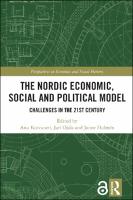The Nordic Economic, Social and Political Model
Challenges in the 21st Century
| dc.contributor.editor | Koivunen, Anu | |
| dc.contributor.editor | Ojala, Jari | |
| dc.contributor.editor | Holmén, Janne | |
| dc.date.accessioned | 2021-04-20T08:10:10Z | |
| dc.date.available | 2021-04-20T08:10:10Z | |
| dc.date.issued | 2021 | |
| dc.identifier | ONIX_20210420_9780429643446_8 | |
| dc.identifier.uri | https://library.oapen.org/handle/20.500.12657/47876 | |
| dc.description.abstract | The Nordic Model is the 20th-century Scandinavian recipe for combining stable democracies, individual freedom, economic growth and comprehensive systems for social security. But what happens when Sweden and Finland – two countries topping global indexes for competitiveness, productivity, growth, quality of life, prosperity, and equality – start doubting themselves and their future? Is the Nordic Model at a crossroads? Historically, consensus, continuity, social cohesion, and broad social trust have been hailed as key components for the success and for the self-images of Sweden and Finland. In the contemporary, however, political debates in both countries are increasingly focused on risks, threats, and worry. Social disintegration, political polarization, geopolitical anxieties, and threat of terrorism are often dominant themes. This book focuses on what appears to be a paradox: countries with low income differences, high faith in social institutions, and relatively high cultural homogeneity becoming fixated on the fear of polarization, disintegration, and diminished social trust. Unpacking the presentist discourse of "worry" and a sense of interregnum at the face of geopolitical tensions, digitalization, and globalization, as well as challenges to democracy, the chapters take steps back in time and explore the current conjecture through the eyes of historians and social scientists, addressing key aspects of and challenges to both the contemporary and future Nordic Model. In addition, the functioning and efficacy of the participatory democracy and current protocols of decision-making are debated. This work is essential reading for students and scholars of the welfare state, social reforms, and populism, as well as Nordic and Scandinavian studies. | |
| dc.language | English | |
| dc.relation.ispartofseries | Perspectives in Economic and Social History | |
| dc.subject.classification | thema EDItEUR::K Economics, Finance, Business and Management::KJ Business and Management | en_US |
| dc.subject.classification | thema EDItEUR::K Economics, Finance, Business and Management::KC Economics::KCZ Economic history | en_US |
| dc.subject.classification | thema EDItEUR::K Economics, Finance, Business and Management::KC Economics | en_US |
| dc.subject.classification | thema EDItEUR::J Society and Social Sciences::JP Politics and government | en_US |
| dc.subject.classification | thema EDItEUR::J Society and Social Sciences::JH Sociology and anthropology::JHB Sociology | en_US |
| dc.subject.other | democratic peace | |
| dc.subject.other | democratic social consensus | |
| dc.subject.other | economic history | |
| dc.subject.other | egalitarian | |
| dc.subject.other | history of welfare states | |
| dc.subject.other | Nordic welfare state | |
| dc.subject.other | national welfare | |
| dc.subject.other | redistribution | |
| dc.subject.other | safety net | |
| dc.subject.other | social history | |
| dc.subject.other | social integration | |
| dc.subject.other | social welfare | |
| dc.subject.other | welfare economics | |
| dc.subject.other | welfare history | |
| dc.subject.other | welfare policy | |
| dc.subject.other | welfare state | |
| dc.title | The Nordic Economic, Social and Political Model | |
| dc.title.alternative | Challenges in the 21st Century | |
| dc.type | book | |
| oapen.identifier.doi | 10.4324/9780429026690 | |
| oapen.relation.isPublishedBy | 7b3c7b10-5b1e-40b3-860e-c6dd5197f0bb | |
| oapen.relation.isbn | 9780429643446 | |
| oapen.relation.isbn | 9780367134754 | |
| oapen.relation.isbn | 9780367724405 | |
| oapen.relation.isbn | 9780429026690 | |
| oapen.imprint | Routledge | |
| oapen.pages | 272 | |
| peerreview.anonymity | Single-anonymised | |
| peerreview.id | bc80075c-96cc-4740-a9f3-a234bc2598f1 | |
| peerreview.open.review | No | |
| peerreview.publish.responsibility | Publisher | |
| peerreview.review.stage | Pre-publication | |
| peerreview.review.type | Proposal | |
| peerreview.reviewer.type | Internal editor | |
| peerreview.reviewer.type | External peer reviewer | |
| peerreview.title | Proposal review | |
| oapen.review.comments | Taylor & Francis open access titles are reviewed as a minimum at proposal stage by at least two external peer reviewers and an internal editor (additional reviews may be sought and additional content reviewed as required). |

